英美小说要素解析 To build a fire
- 格式:ppt
- 大小:1.08 MB
- 文档页数:10
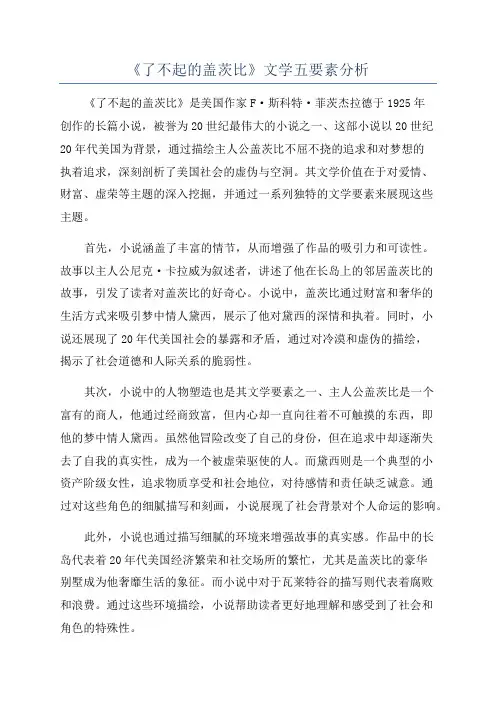
《了不起的盖茨比》文学五要素分析《了不起的盖茨比》是美国作家F·斯科特·菲茨杰拉德于1925年创作的长篇小说,被誉为20世纪最伟大的小说之一、这部小说以20世纪20年代美国为背景,通过描绘主人公盖茨比不屈不挠的追求和对梦想的执着追求,深刻剖析了美国社会的虚伪与空洞。
其文学价值在于对爱情、财富、虚荣等主题的深入挖掘,并通过一系列独特的文学要素来展现这些主题。
首先,小说涵盖了丰富的情节,从而增强了作品的吸引力和可读性。
故事以主人公尼克·卡拉威为叙述者,讲述了他在长岛上的邻居盖茨比的故事,引发了读者对盖茨比的好奇心。
小说中,盖茨比通过财富和奢华的生活方式来吸引梦中情人黛西,展示了他对黛西的深情和执着。
同时,小说还展现了20年代美国社会的暴露和矛盾,通过对冷漠和虚伪的描绘,揭示了社会道德和人际关系的脆弱性。
其次,小说中的人物塑造也是其文学要素之一、主人公盖茨比是一个富有的商人,他通过经商致富,但内心却一直向往着不可触摸的东西,即他的梦中情人黛西。
虽然他冒险改变了自己的身份,但在追求中却逐渐失去了自我的真实性,成为一个被虚荣驱使的人。
而黛西则是一个典型的小资产阶级女性,追求物质享受和社会地位,对待感情和责任缺乏诚意。
通过对这些角色的细腻描写和刻画,小说展现了社会背景对个人命运的影响。
此外,小说也通过描写细腻的环境来增强故事的真实感。
作品中的长岛代表着20年代美国经济繁荣和社交场所的繁忙,尤其是盖茨比的豪华别墅成为他奢靡生活的象征。
而小说中对于瓦莱特谷的描写则代表着腐败和浪费。
通过这些环境描绘,小说帮助读者更好地理解和感受到了社会和角色的特殊性。
总之,《了不起的盖茨比》通过丰富多样的情节、鲜明独特的人物塑造、细腻描绘的环境、巧妙运用的文学手法等文学要素的运用,揭示了20年代美国社会的矛盾和人性的脆弱。
这部小说不仅具有很高的艺术价值,而且深入挖掘了人类社会的本质和困境,对于读者来说具有深远的思考和启示意义。
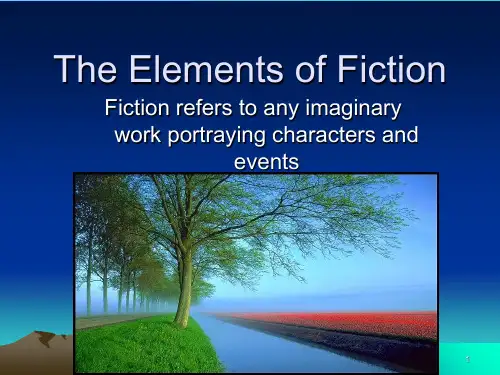

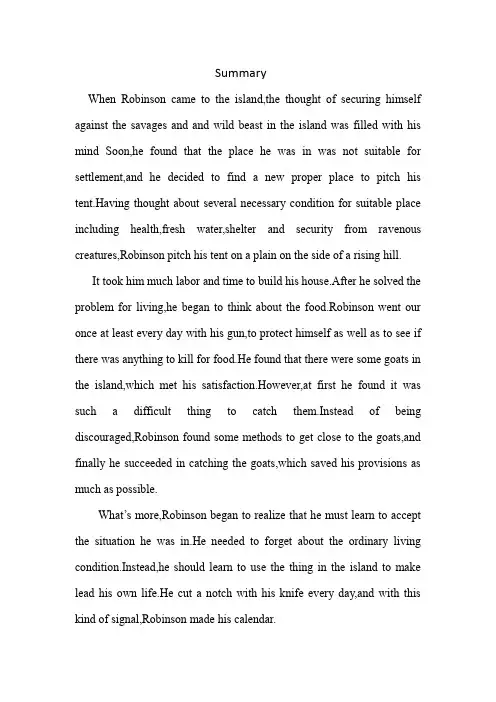
SummaryWhen Robinson came to the island,the thought of securing himself against the savages and and wild beast in the island was filled with his mindSoon,he found that the place he was in was not suitable for settlement,and he decided to find a new proper place to pitch his tent.Having thought about several necessary condition for suitable place including health,fresh water,shelter and security from ravenous creatures,Robinson pitch his tent on a plain on the side of a rising hill.It took him much labor and time to build his house.After he solved the problem for living,he began to think about the food.Robinson went our once at least every day with his gun,to protect himself as well as to see if there was anything to kill for food.He found that there were some goats in the island,which met his satisfaction.However,at first he found it was such a difficult thing to catchthem.Instead of being discouraged,Robinson found some methods to get close to the goats,and finally he succeeded in catching the goats,which saved his provisions as much as possible.What’s more,Robinson began to realize that he must learn to accept the situation he was in.He needed to forget about the ordinary living condition.Instead,he should learn to use the thing in the island to make lead his own life.He cut a notch with his knife every day,and with this kind of signal,Robinson made his calendar.。
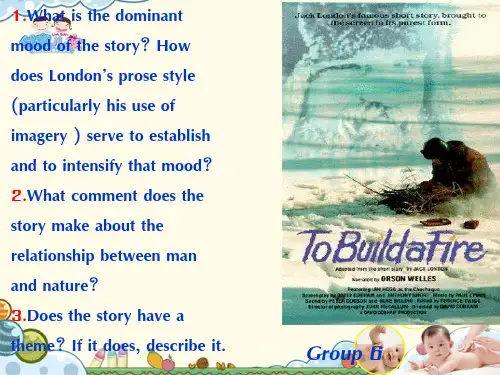
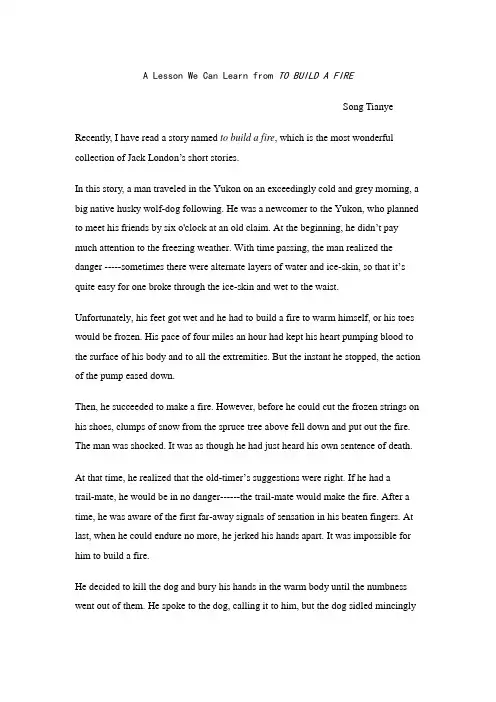
A Lesson We Can Learn from TO BUILD A FIRESong TianyeRecently, I have read a story named to build a fire, which is the most wonderful collection of Jack London’s short stories.In this story, a man traveled in the Yukon on an exceedingly cold and grey morning, a big native husky wolf-dog following. He was a newcomer to the Yukon, who planned to meet his friends by six o'clock at an old claim. At the beginning, he didn’t pay much attention to the freezing weather. With time passing, the man realized the danger -----sometimes there were alternate layers of water and ice-skin, so that it’s quite easy for one broke through the ice-skin and wet to the waist.Unfortunately, his feet got wet and he had to build a fire to warm himself, or his toes would be frozen. His pace of four miles an hour had kept his heart pumping blood to the surface of his body and to all the extremities. But the instant he stopped, the action of the pump eased down.Then, he succeeded to make a fire. However, before he could cut the frozen strings on his shoes, clumps of snow from the spruce tree above fell down and put out the fire. The man was shocked. It was as though he had just heard his own sentence of death.At that time, he realized that the old-timer’s suggestions were right. If he had atrail-mate, he would be in no danger------the trail-mate would make the fire. After a time, he was aware of the first far-away signals of sensation in his beaten fingers. At last, when he could endure no more, he jerked his hands apart. It was impossible for him to build a fire.He decided to kill the dog and bury his hands in the warm body until the numbness went out of them. He spoke to the dog, calling it to him, but the dog sidled mincinglyaway. The man lost his control. His arms flashed out to the dog and the animal got away at once.A certain fear of death, dull and oppressive, came to him. He started to run and felt better. However, it was too many miles away. He considered himself a fool, who run around like a chicken with its head cut off. He did n’t belong to himself any more, for even then he was out of himself, standing with the boys who would find his body next day and looking at himself in the snow.At the end of the story, the man drowsed off into what seemed to him the most comfortable and satisfying sleep he ever known. He was dead and the dog bristle and back away.After having read the story, I felt very sad and shocked. It occurs to me that most of us are unwise, like the man in the story, to face the life but gain failure in the end.At the beginning, a man doesn’t know the feeling of fear. He gains knowledge from the school and life. When he meets with various difficulties, he always tries his best to move away the barrier by himself. In this case, he becomes conceited and refuses to cooperate with other people. To the worse, in the future, he may ignore the warnings, which old-timers give to him.Of course, he will gain failure in the end and give to the life with a sense of regret.Losers are these people who never learn from lessons. In our personal lives, we always read other people’s tragedies, blaming for their mistakes. We put a wild idea into our own heads that we won’t make these kinds of faults. However, we just repeat performing the tragedy for other people. That is to say only when we are trapped into impasses, can we think of old-timers’ advice.What’s more, as far as I am concerned, besides that we should learn something from lessons, all of us should also recognize the importance of having companies, withwhom we won’t feel lonely or helpless in any case. Living a life is just like take a train. A friend is a gift that you give yourself and the trip will be interesting.At last ,this point is also very important——never want to make the purpose by sacrifice our friends. If you drop your friend in the danger, don’t pray that he will still company with you. Great friendship is always based on sufferings. On the contrary, we should make true friends.The life is full of chances. It doesn’t mean that if someone fails once, he will lose the entire life. This story is just a good lesson for us.I feel lucky to read this story, because of which I can learn so much.。
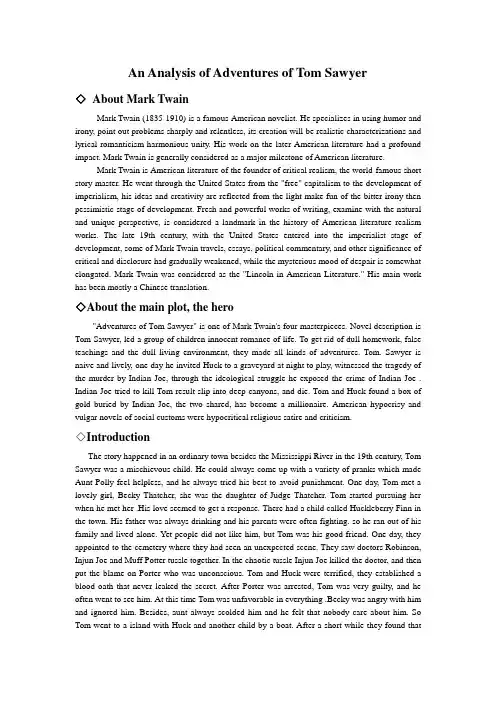
An Analysis of Adventures of Tom Sawyer◇About Mark TwainMark Twain (1835-1910) is a famous American novelist. He specializes in using humor and irony, point out problems sharply and relentless, its creation will be realistic characterizations and lyrical romanticism harmonious unity. His work on the later American literature had a profound impact. Mark Twain is generally considered as a major milestone of American literature.Mark Twain is American literature of the founder of critical realism, the world-famous short story master. He went through the United States from the "free" capitalism to the development of imperialism, his ideas and creativity are reflected from the light make fun of the bitter irony then pessimistic stage of development. Fresh and powerful works of writing, examine with the natural and unique perspective, is considered a landmark in the history of American literature realism works. The late 19th century, with the United States entered into the imperialist stage of development, some of Mark Twain travels, essays, political commentary, and other significance of critical and disclosure had gradually weakened, while the mysterious mood of despair is somewhat elongated. Mark Twain was considered as the "Lincoln in American Literature." His main work has been mostly a Chinese translation.◇About the main plot, the hero"Adventures of Tom Sawyer" is one of Mark Twain's four masterpieces. Novel description is Tom Sawyer, led a group of children innocent romance of life. To get rid of dull homework, false teachings and the dull living environment, they made all kinds of adventures. Tom. Sawyer is naive and lively, one day he invited Huck to a graveyard at night to play, witnessed the tragedy of the murder by Indian Joe, through the ideological struggle he exposed the crime of Indian Joe . Indian Joe tried to kill Tom result slip into deep canyons, and die. Tom and Huck found a box of gold buried by Indian Joe, the two shared, has become a millionaire. American hypocrisy and vulgar novels of social customs were hypocritical religious satire and criticism.◇IntroductionThe story happened in an ordinary town besides the Mississippi River in the 19th century, Tom Sawyer was a mischievous child. He could always come up with a variety of pranks which made Aunt Polly feel helpless, and he always tried his best to avoid punishment. One day, Tom met a lovely girl, Becky Thatcher, she was the daughter of Judge Thatcher. Tom started pursuing her when he met her .His love seemed to get a response. There had a child called Huckleberry Finn in the town. His father was always drinking and his parents were often fighting. so he ran out of his family and lived alone. Yet people did not like him, but Tom was his good friend. One day, they appointed to the cemetery where they had seen an unexpected scene. They saw doctors Robinson, Injun Joe and Muff Potter tussle together. In the chaotic tussle Injun Joe killed the doctor, and then put the blame on Porter who was unconscious. Tom and Huck were terrified, they established a blood oath that never leaked the secret. After Porter was arrested, Tom was very guilty, and he often went to see him. At this time Tom was unfavorable in everything .Becky was angry with him and ignored him. Besides, aunt always scolded him and he felt that nobody care about him. So Tom went to a island with Huck and another child by a boat. After a short while they found thatthe people of the village thought they had died. And villagers were searching for their bodies. Tom returned to his aunt at night quietly and found that aunt Polly was sad for his death. Tom felt so ashamed. In the end, they came back when villagers were holding funeral for them. Summer was coming, Tom felt more anxious, because the judge would make a decision to Porter's crime. Tom finally overcame fear and selfishness, then he reported that Injun Joe was the murderer. But murderer escaped at last. Later, Tom came up with an idea to find treasures. Tom and Huck found Injun Joe and his ill-gotten gains. However, they did not know where he hid his money was. When Becky and students got out to have a picnic, Huck had known Joe wanted to harm Douglas because of her husband, who had sent him to prison. Thanks to Huck's message they avoided a tragedy, but Injun Joe escaped again. At this point, Tom and Becky entered a cave when they had a picnic .The hole was so deep that they could not find the way to come back. They met Injun Joe in the cave again. The villagers made great efforts to pull Tom and Becky out of death and then closed the cave. Later, Tom told the villagers that Injun Joe was still inside. When they found him, he had died in the cave. At last,Tom and Huck returned to the cave and found the treasures .◇Character analysisTom Sawyer’s Innocence and RomanceIn The Adventures of Tom Sawyer, Mark Twain managers his delicate pen well to delineate Tom’s romance with Becky Thatcher, a beautiful girl who attracts Tom at their first encounter. Tom immediately loses himself, and he forgets Amy Lawrence, with whom Tom makes engagement before.Tom Sawyer’s WitMark Twain here uses Tom’s whitewashing to express his own thoughts. The difference between play and work, Mark Twain points out that work consists of whatever a body is obliged to do and play consists of whatever a body is not obliged to do. He powerfully criticizes the luxury of the aristocratic life. The wealthy gentlemen do not work but indulge themselves in wasting wealth.Tom Sawyer’s HeroismTom becomes a hero. People celebrate their narrow escape, and commend Tom’s brave deeds. Aunt Polly is proud of him too. After a series of adventure, Tom Sawyer’s personality has transformed from a naughty boy to a little hero. Mark Twain shows us a bad boy is possible to be a great hero, while the good boy can merely be a spectator. Mark Twain exagerates Tom Sawyer’s braveness to express his commends to the boy’s heroism, meanwhile, he tries to attack the stubborn traditional educational system. Tom Sawyer is naughty, adventurous, and desirous for freedom. The Adventures of Tom Sawyer actually awakens people’s instinct s that hide themselves in the bottom of heart. No matter how old one is, he is eager to be Tom Sawyer in the other side of his heart.◇The main idea"Adventures of Tom Sawyer" described Tom, a little boy, hating the boring living environment at home and school, longing for adventure and the pursuit of outdoor life. This novel meets the boys for the fame, heroism, gold and silver wealth and adulation of the deepest aspirations, and vividly depicts the scene of life in an American frontier town before the Civil War, not only can people enjoy the beauty, but also can make the nostalgia was tremendous satisfaction. Its description ofTom and other children's behavior and mental activity has universal significance, can inspire many people's interests. Structure of the novel is also complete. It has the "four narrative units" and "four plot lines": the story of Tom and Huck, the story of Tom and Muff Potter, Jackson’s Island and a series of events led to the discovery of wealth. These four plot lines are organically intertwined, so that the book has a strong dramatic color. The novel's more detailed psychological description, the narrator is the view that an adult used to observe the little boy. "Adventures of Tom Sawyer" is indeed a good book worthy of appreciation. As a memorial to the early frontier life in the United States, it has a very valuable historical significance, and as an idea of the perfect, the characters vivid novel, it has high artistic value and aesthetic value.。
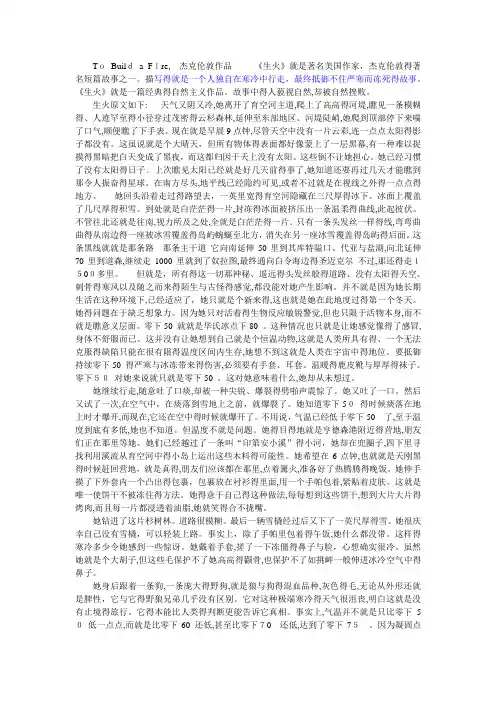
ToBuilda Fire,杰克伦敦作品《生火》就是著名美国作家,杰克伦敦得著名短篇故事之一。
描写得就是一个人独自在寒冷中行走,最终抵御不住严寒而冻死得故事。
《生火》就是一篇经典得自然主义作品。
故事中得人藐视自然,却被自然挫败。
生火原文如下: 天气又阴又冷,她离开了育空河主道,爬上了高高得河堤,瞧见一条模糊得、人迹罕至得小径穿过茂密得云杉森林,延伸至东部地区。
河堤陡峭,她爬到顶部停下来喘了口气,顺便瞧了下手表。
现在就是早晨9点钟,尽管天空中没有一片云彩,连一点点太阳得影子都没有。
这虽说就是个大晴天,但所有物体得表面都好像蒙上了一层黑幕,有一种难以捉摸得黑暗把白天变成了黑夜,而这都归因于天上没有太阳。
这些倒不让她担心。
她已经习惯了没有太阳得日子。
上次瞧见太阳已经就是好几天前得事了,她知道还要再过几天才能瞧到那令人振奋得星球。
在南方尽头,地平线已经隐约可见,或者不过就是在视线之外得一点点得地方。
她回头沿着走过得路望去,一英里宽得育空河隐藏在三尺厚得冰下。
冰面上覆盖了几尺厚得积雪。
到处就是白茫茫得一片,封冻得冰面被挤压出一条温柔得曲线,此起彼伏。
不管往北还就是往南,视力所及之处,全就是白茫茫得一片。
只有一条头发丝一样得线,弯弯曲曲得从南边得一座被冰雪覆盖得岛屿蜿蜒至北方,消失在另一座冰雪覆盖得岛屿得后面。
这条黑线就就是那条路那条主干道它向南延伸50里到其库特隘口、代亚与盐湖,向北延伸70里到道森,继续走1000里就到了奴拉图,最终通向白令海边得圣迈克尔不过,那还得走1500多里。
但就是,所有得这一切那神秘、遥远得头发丝般得道路、没有太阳得天空、刺骨得寒风以及随之而来得陌生与古怪得感觉,都没能对她产生影响。
并不就是因为她长期生活在这种环境下,已经适应了,她只就是个新来得,这也就是她在此地度过得第一个冬天。
她得问题在于缺乏想象力。
因为她只对活着得生物反应敏锐警觉,但也只限于活物本身,而不就是瞧意义层面。
零下50 就就是华氏冰点下80 。
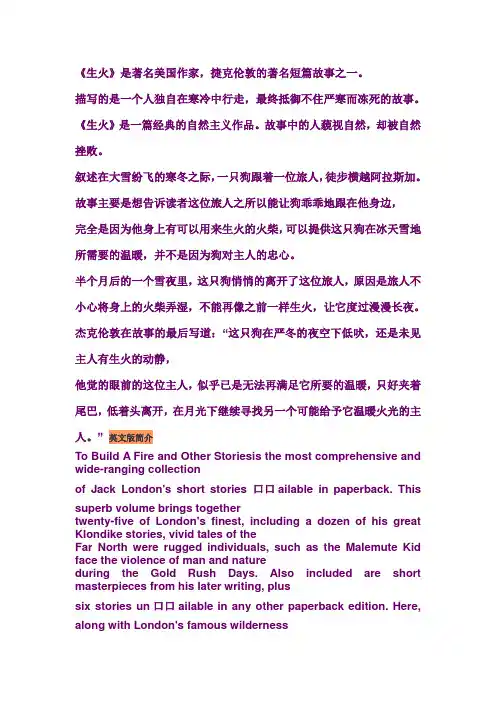
《生火》是著名美国作家,捷克伦敦的著名短篇故事之一。
描写的是一个人独自在寒冷中行走,最终抵御不住严寒而冻死的故事。
《生火》是一篇经典的自然主义作品。
故事中的人藐视自然,却被自然挫败。
叙述在大雪纷飞的寒冬之际,一只狗跟着一位旅人,徒步横越阿拉斯加。
故事主要是想告诉读者这位旅人之所以能让狗乖乖地跟在他身边,完全是因为他身上有可以用来生火的火柴,可以提供这只狗在冰天雪地所需要的温暖,并不是因为狗对主人的忠心。
半个月后的一个雪夜里,这只狗悄悄的离开了这位旅人,原因是旅人不小心将身上的火柴弄湿,不能再像之前一样生火,让它度过漫漫长夜。
杰克伦敦在故事的最后写道:“这只狗在严冬的夜空下低吠,还是未见主人有生火的动静,他觉的眼前的这位主人,似乎已是无法再满足它所要的温暖,只好夹着尾巴,低着头离开,在月光下继续寻找另一个可能给予它温暖火光的主人。
” 英文版简介To Build A Fire and Other Storiesis the most comprehensive and wide-ranging collectionof Jack London's short stories 口口ailable in paperback. This superb volume brings togethertwenty-five of London's finest, including a dozen of his great Klondike stories, vivid tales of theFar North were rugged individuals, such as the Malemute Kid face the violence of man and natureduring the Gold Rush Days. Also included are short masterpieces from his later writing, plussix stories un口口ailable in any other paperback edition. Here, along with London's famous wildernessadventures and fireband desperadoes, are portraits of the working man, the immigrant, and the exoticoutcast: characters representing the entire span of the author's prolific imaginative career, in tales thath口口e been acclaimed throughout the world as some of the most thrilling short stories ever written.There is a man in Alaska who wanted a camp near Henderson Creek.And,his friends have already been thereTo Build a Fire SummaryA man travels in the Yukon (in Alaska) on an extremely cold morning with a husky wolf-dog. The cold does not faze the man, a newcomer to the Yukon, who plans to meet his friends by six o'clock at an old claim. As it grows colder, he realizes his unprotected cheekbones will freeze, but he does not pay it much attention. He walks along a creek trail, mindful of the dangerous, concealed springs; even getting wet feet on such a cold day is extremely dangerous. He stops for lunch and builds a fire.The man continues on and, in a seemingly safe spot, falls through the snow and wets himself up to his shins. He curses his luck; starting a fire and drying hisfoot-gear will delay him at least an hour. His feet and fingers are numb, but he starts the fire. He remembers the old-timer from Sulphur Creek who had warned him that no man should travel in the Klondike alone when the temperature was fifty degrees below zero.The man unties his icy moccasins, but before he can cut the frozen strings on them, clumps of snow from the spruce tree above fall down and snuff out the fire. Though building a fire in the open would have been wiser, it had been easier for the man to take twigs from the spruce tree and drop them directly below on to the fire. Each time he pulled a twig, he had slightly agitated the tree until, at this point, a bough high up had capsized its load of snow. It capsized lower boughs in turn until a small avalanche had blotted out the fire.The man is scared, and sets himself to building a new fire, aware that he is already going to lose a few toes from frostbite. He gathers twigs and grasses. His fingers numb and nearly lifeless, he unsuccessfully attempts to light a match. He grabs all his matches--seventy--and lights them simultaneously, then sets fire to a piece ofbark. He starts the fire, but in trying to protect it from pieces of moss, it soon goes out.The man decides to kill the dog and puts his hands inside its warm body to restore his circulation. He calls out to the dog, but something fearful and strange in his voice frightens the dog. The dog finally comes forward and the man grabs it in his arms. But he cannot kill the dog, since he is unable to pull out his knife or even throttle the animal. He lets it go.The man realizes that frostbite is now a less worrisome prospect than death. He panics and runs along the creek trail, trying to restore circulation, the dog at his heels. But his endurance gives out, and finally he falls and cannot rise. He fights against the thought of his body freezing, but it is too powerful a vision, and he runs again. He falls again, and makes one last panicked run and falls once more. He decides he should meet death in a more dignified manner. He imagines his friends finding his body tomorrow.The man falls off into a comfortable sleep. The dog does not understand why the man is sitting in the snow like that without making a fire. As the night comes, it comes closer and detects death in the man's scent. It runs away in the direction of the camp, "where were the other food-providers and fire-providers."。

T o B u i l d a F i r e生火中文翻译杰克伦敦Company number【1089WT-1898YT-1W8CB-9UUT-92108】ToBuildaFire,杰克伦敦作品《生火》是着名美国作家,杰克伦敦的着名短篇故事之一。
描写的是一个人独自在寒冷中行走,最终抵御不住严寒而冻死的故事。
《生火》是一篇经典的自然主义作品。
故事中的人藐视自然,却被自然挫败。
生火原文如下:天气又阴又冷,他离开了育空河主道,爬上了高高的河堤,看见一条模糊的、人迹罕至的小径穿过茂密的云杉森林,延伸至东部地区。
河堤陡峭,他爬到顶部停下来喘了口气,顺便看了下手表。
现在是早晨9点钟,尽管天空中没有一片云彩,连一点点太阳的影子都没有。
这虽说是个大晴天,但所有物体的表面都好像蒙上了一层黑幕,有一种难以捉摸的黑暗把白天变成了黑夜,而这都归因于天上没有太阳。
这些倒不让他担心。
他已经习惯了没有太阳的日子。
上次看见太阳已经是好几天前的事了,他知道还要再过几天才能看到那令人振奋的星球。
在南方尽头,地平线已经隐约可见,或者不过是在视线之外的一点点的地方。
他回头沿着走过的路望去,一英里宽的育空河隐藏在三尺厚的冰下。
冰面上覆盖了几尺厚的积雪。
到处是白茫茫的一片,封冻的冰面被挤压出一条温柔的曲线,此起彼伏。
不管往北还是往南,视力所及之处,全是白茫茫的一片。
只有一条头发丝一样的线,弯弯曲曲的从南边的一座被冰雪覆盖的岛屿蜿蜒至北方,消失在另一座冰雪覆盖的岛屿的后面。
这条黑线就是那条路那条主干道它向南延伸50里到其库特隘口、代亚和盐湖,向北延伸70里到道森,继续走1000里就到了奴拉图,最终通向白令海边的圣迈克尔不过,那还得走1500多里。
但是,所有的这一切那神秘、遥远的头发丝般的道路、没有太阳的天空、刺骨的寒风以及随之而来的陌生和古怪的感觉,都没能对他产生影响。
并不是因为他长期生活在这种环境下,已经适应了,他只是个新来的,这也是他在此地度过的第一个冬天。
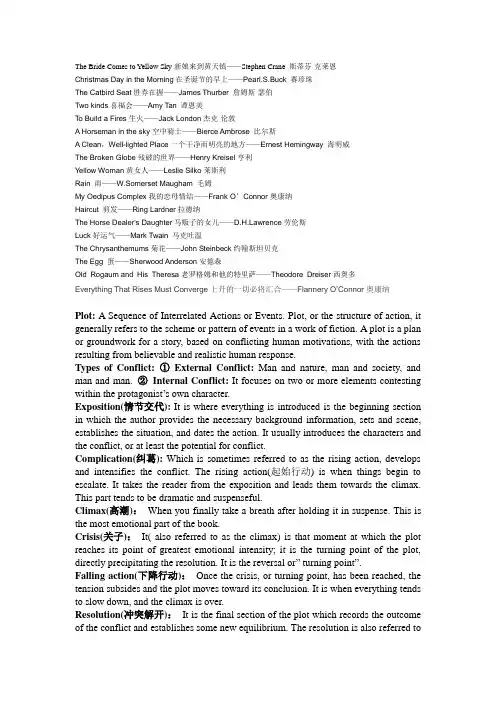
The Bride Comes to Yellow Sky新娘来到黄天镇——Stephen Crane 斯蒂芬·克莱恩Christmas Day in the Morning在圣诞节的早上——Pearl.S.Buck 赛珍珠The Catbird Seat胜券在握——James Thurber 詹姆斯·瑟伯Two kinds喜福会——Amy Tan 谭恩美To Build a Fires生火——Jack London杰克·伦敦A Horseman in the sky空中骑士——Bierce Ambrose 比尔斯A Clean,Well-lighted Place一个干净而明亮的地方——Ernest Hemingway 海明威The Broken Globe残破的世界——Henry Kreisel亨利Yellow Woman黄女人——Leslie Silko莱斯利Rain 雨——W.Somerset Maugham 毛姆My Oedipus Complex我的恋母情结——Frank O’Connor奥康纳Haircut 剪发——Ring Lardner拉德纳The Horse Dealer's Daughter马贩子的女儿——wrence劳伦斯Luck好运气——Mark Twain 马克吐温The Chrysanthemums菊花——John Steinbeck约翰斯坦贝克The Egg 蛋——Sherwood Anderson安德森Old Rogaum and His Theresa老罗格姆和他的特里萨——Theodore Dreiser西奥多Everything That Rises Must Converge上升的一切必将汇合——Flannery O’Connor奥康纳Plot: A Sequence of Interrelated Actions or Events. Plot, or the structure of action, it generally refers to the scheme or pattern of events in a work of fiction. A plot is a plan or groundwork for a story, based on conflicting human motivations, with the actions resulting from believable and realistic human response.Types of Conflict:①External Conflict: Man and nature, man and society, and man and man.②Internal Conflict: It focuses on two or more elements contesting within the protagonist’s own character.Exposition(情节交代): It is where everything is introduced is the beginning section in which the author provides the necessary background information, sets and scene, establishes the situation, and dates the action. It usually introduces the characters and the conflict, or at least the potential for conflict.Complication(纠葛): Which is sometimes referred to as the rising action, develops and intensifies the conflict. The rising action(起始行动) is when things begin to escalate. It takes the reader from the exposition and leads them towards the climax. This part tends to be dramatic and suspenseful.Climax(高潮):When you finally take a breath after holding it in suspense. This is the most emotional part of the book.Crisis(关子):It( also referred to as the climax) is that moment at which the plot reaches its point of greatest emotional intensity; it is the turning point of the plot, directly precipitating the resolution. It is the reversal or” turning point”.Falling action(下降行动):Once the crisis, or turning point, has been reached, the tension subsides and the plot moves toward its conclusion. It is when everything tends to slow down, and the climax is over.Resolution(冲突解开):It is the final section of the plot which records the outcome of the conflict and establishes some new equilibrium. The resolution is also referred toas the conclusion, the end or the denouement. This is the final part of the story when everything is wrapped up. Sometimes the story is finished off completely, answering every reader's question. Sometimes authors leave mysterious, to intrigue the reader. Or sometimes authors leave hints of a sequel.Catastrophe: Applied to tragedy only.Denouement:Applied to both comedy and tragedy.The ordering of plot—Chronological plotting—Flashback: It is interpolated narratives or scenes( often justified, or naturalized, as a memory, a reverie, or a confession by one of the characters) which represent events that happened before the time at which the work opened.Character:They are the persons represented in a dramatic or narrative work, who are interpreted by the reader as being endowed with particular moral, intellectual, and emotional qualities by inferences from what the persons say and their distinctive ways of saying it –the dialogue—and from what they do—the action. A character may remain essentially“stable,”or unchanged in outlook and disposition, from beginning to end of a work, or may undergo a radical change, either through a gradual process of development, or as the result of a crisis. Whether a character remains stable or changes, the reader of a traditional and realistic work expects “consistency”--- ---the character should not suddenly break off and act in a way not plausibly grounded in his or her temperament as we have already come to know it.Motivation: The grounds in the characters temperament, desires, and moral nature for their speech and actions.Types of characters—protagonist: The chief character in a plot, on whom our interest centers.(or alternatively, the hero or heroine) It is the major, or central, character of the plot.Antagonist: If the plot is such that he or she is pitted against and important opponent, that character is called the antagonist. It is his opponent, the character against whom the protagonist struggles or contends.Flat characters: they are those who embody or represent a single characteristic, trait, or idea, or at most a very limited number of such qualities. Flat characters are also referred to as type characters, as one-dimensional characters, or when they are distorted to create humor, as caricatures.Stock characters: Flat characters have much in common with the kind of stock characters who appear again and again in certain types of literary works. A flat character (also called a type, or “two-dimensional”), Forster says, is built around “a single idea or quality”and is presented without much individualizing detail, and therefore can be fairly adequately described in a single phrase or sentence.Round characters: They are just the opposite. They embody a number of qualities and traits, and are complex multidimensional characters of considerable intellectual and emotional depth who have the capacity to grow and change. A round character is complex in temperament and motivation and is represented with subtle particularity; such a character therefore is as difficult to describe with any adequacy as a person in real life, and like real persons, is capable of surprising us.Dynamic characters: They exhibit a capacity to change; static characters do not. Asmight be expected, the degree and rate of character change varies widely even among dynamic characters.Static characters: They leave the plot as they entered it, largely untouched by the events that have taken place.Methods of characterization-- Telling: It relies on exposition and direct commentary by the author.In telling, the author intervenes authoritatively in order to describe, and often to evaluate, the motives and dispositional qualities of the characters. Characterization through the use of names, through appearance, and by the author. Showing: It involves the author’s stepping aside, as it were, to allow the characters to reveal themselves directly through their dialogue and their actions. In showing(also called“the dramatic method”), the author simply presents the characters talking and acting and leaves the reader to infer the motives and dispositions that lie behind what they say and do.The author may show not only external speech and actions, but also a character’s inner thoughts, feelings, and responsiveness to events; for a highly developed mode of such inner showing, see stream of consciousness. Characterization through dialogue, and action.Setting: The stage against which the story unfolds.( Place and objects in fiction) The overall setting of a narrative or dramatic work is the general locale, historical time, and social circumstances in which its action occurs; the setting of a single episode or scene within such a work is the particular physical location in which it takes place. Types of setting—Natural and ManufacturedThe language used in description of settingThe functions of setting: Setting as a background for action, antagonist, a means of creating appropriate atmosphere, a means of revealing character, and a means of reinforcing theme.Point of view: The events of a story may be told as they appear to one or more participants or observers. In first-person narration the point of view is automatically that of the narrator.More variation is possible in third-person narration, where the author may choose to limit his or her report to what could have been observed or known by one of the characters at any given point in the action--- or may choose to report the observations and thoughts of several characters. The author might choose to intrude his or her own point of view.Narrator: It is the speaker or the voice of the literary text, the agent who does the narration. The narrator, like any character in fiction, only exists in a narrative, and he cannot be identified with anything of the real-life author of a literary work.Various points of view—First person:①Advantages: First, he creates an immediate sense of reality. Second, the writer has a ready-made principle of selection.② Difficulties: It may only strike us when we try to write stories ourselves.Second personThird person: There are three variants: omniscient, limited omniscient, and objective or dramatic.Mingling of points of view: It is because for the purpose of sustaining interest or creating suspense.A brief summary: 1. First person( I): All these first-person narrators may have(1)complete understanding,(2) partial or incorrect understanding, or(3) no understanding at all.①Major participantⅰtelling his or her story as a major mover,ⅱtelling a story about others and also about herself or himself as one of the major inter-actors,ⅲtelling a story mainly about others; this narrator is on the spot and completely involved but is not a major mover.②Minor participant, telling a story about events experienced and/ or witnessed.③Uninvolved character, telling a story not witnessed but reported to the narrator by other means. 2. Second person( you): Occurs only when speaker has more authority on a character’s action than the character himself or herself. Occurs only in brief passages when necessary. 3. Third person( she, he, it, they):①Omniscient. Omniscient speaker sees all, reports all, knows inner workings of minds of characters.②Limited omniscient. Action is focused on one major character.③Dramatic or third-person objective. Speaker reports only actions and speeches. Thoughts of characters can be expressed only as dialogue.Theme: It is the central idea or a statement about life that unifies and controls the total work.Points of theme:1. A theme does not exist as an intellectual abstraction that an author superimposes on the work like icing on a cake.2. The theme may be less prominent and less fully developed in some works of fiction than in others.3. It is entirely possible that intelligent readers will differ, at times radically, on just what the theme of a given a work is.4. The theme of a given work need not be in accord with the reader’s particular beliefs and values. As a general rule, then, we should assume that the ideas of authors grow out of their values, and that values are embodied in their stories along with the ideas. But we must remember that although literature is full of ideas that may strike us, at least initially, as unpleasant, controversial, or simply wrongheaded, literary sophistication and plain common sense should warn us against dismissing them out of hand.Identifying theme:1. It is important to avoid confusing a work’s theme with its subject or situation.2. We must be as certain as we can that our statement of theme does the work full.3. The test of any theme we may propose is whether it is fully and completely supported by the work’s other elements.4. The title an author gives the work often suggests a particular focus or emphasis for the reader’s attention.Style: It has traditionally been defined as the manner of linguistic expression in Prose or verse--as how speakers or writers say whatever it is that they say. TheWord style, derived from the Latin word stilus, is understood to mean the way in which writers assemble words to tell the story, develop the argument, dramatize the play, or compose the poem. Style is to be judged on the degree of its adaptability. Elements of style—Diction: Choice of words, and Syntax: Construction of sentences.Oedipus complex: ①It is a term coined by Sigmund Freud to designate a son’s subconscious feeling of love toward his mother and jealousy and hatred toward his father. ②D.H. Lawrence’s Sons and Lovers is a case in point.Tone: It refers to the methods by which writers convey attitudes, it refers not to attitudes but to those techniques and modes of presentation that reveal or create these attitudes. It is a means of creating a relationship or conveying an attitude.Types of irony:1. Verbal irony: It is a statement in which one thing is said and another is meant.2. Situational irony: It or irony of situation, refers to conditions that are measured against forces that transcend and overpower human capacities.3. Dramatic irony: It is a special kind of situational irony; it applies when a character perceives a situation in a limited way while the audience, including other characters, may see it in greater perspective.1.1 The Bride Comes to Yellow Sky—Stephen Crane 1.2 Christmas Day in the Morning—Pearl S. Buck2.1 The Catbird Seat—James Thurber 2.2 Two kinds—Amy Tan3.1 To Build a Fire—Jack London 3.2 A Horseman in the Sky—Ambrose Bierce4.1 A Clean, Well-lighted Place—Ernest Hemingway 4.2 The Broken Globe—Henry Kreisel5.1 Yellow Woman—Leslie Silko 5.2 Rain—W. Somerset Maugham6.1 My Oedipus Complex—Frank O’Connor 6.2 Haircut—Ring Lardner7.1 The Horse Dealer’s Daughter—D.H. Lawrence 7.2 Luck—Mark Twain。
九年级英语文学作品主题分析练习题40题1. In "The Gift of the Magi", the main theme is about _____.A.love and sacrificeB.adventure and courageC.mystery and suspenseD.humor and entertainment答案:A。
解析:《麦琪的礼物》主要讲述了一对夫妻为了给对方买礼物而做出的牺牲,体现了爱与牺牲的主题。
选项B 冒险和勇气与该小说内容不符;选项C 神秘和悬念也不是该小说的主题;选项D 幽默和娱乐不是小说的主要主题。
2. "The Necklace" mainly reflects _____.A.vanity and its consequencesB.friendship and loyaltyC.hope and perseveranceD.kindness and generosity答案:A。
解析:《项链》主要反映了女主人公的虚荣以及虚荣带来的后果。
选项B 友谊和忠诚不是该小说的主要体现;选项C 希望和坚持与小说内容不符;选项D 善良和慷慨不是该小说的主题。
3. In the short story "The Tell-Tale Heart", the theme is related to _____.A.guilt and conscienceB.ambition and successC.loneliness and isolationD.optimism and positivity答案:A。
解析:《泄密的心》讲述了一个人因杀人而产生的内疚和良心的谴责。
选项B 野心和成功与该小说无关;选项C 孤独和隔离不是该小说的主要主题;选项D 乐观和积极与小说内容相反。
4. "The Most Dangerous Game" centers on the theme of _____.A.survival and competitionB.romance and passionC.forgiveness and reconciliationD.creativity and imagination答案:A。